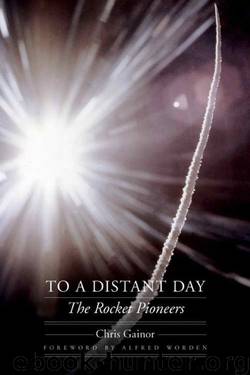To a Distant Day - The Rocket Pioneers by Chris Gainor

Author:Chris Gainor [Gainor, Chris]
Language: eng
Format: epub
ISBN: 9780803222090
Publisher: U of Nebraska Press
Published: 2013-09-15T16:00:00+00:00
Breaking the Sound Barrier
Humans, not just animals, were also being subjected to new speeds and acceleration forces in the first decade after the war, sometimes with similarly fatal results. At the time of Project Blossom, humans were flying in revolutionary new aircraft whose forms were based on the major advances in aircraft design and engineering that took place in anticipation of and during World War II. Aircraft designers in America, Britain, Germany, and Russia were scrambling to build aircraft that incorporated improvements in engine and airframe design. In the United States, much of this work was done by the National Advisory Committee for Aeronautics (naca), a government agency set up in 1915 that conducted research on aerodynamics and aircraft engines in laboratories in Virginia, Ohio, and California. The results of Naca's work were shared with the growing U.S. aircraft industry, which developed innovations of its own. Aircraft built with these advances played a crucial role in helping American and allied airpower defeat Germany and Japan.
Just a few days before Hitler's invasion of Poland opened hostilities, the first jet aircraft took to the air in Germany. Yet the overwhelming majority of the aircraft that flew in World War II were powered by propellers, and jet aircraft did not become widespread until after the war. Erich Warsitz flew that first jet on August 27,1939, in an aircraft designed by Ernst Heinkel, with jet engines designed by Hans von Ohain, a graduate of Gottingen University. Warsitz had earlier distinguished himself by flying the first rocket planes in collaboration with Heinkel and Wernher von Braun. But Ohain's new jet engine was more immediately promising for military use because unlike rockets, which carry both fuel and oxidizer, the jet engine drew its oxidizer from the air. The German government was interested in jet-powered aircraft, and both the Heinkel and Messerschmitt companies set to work on building aircraft. The only jet aircraft deployed in any significant numbers during the war was the Messerschmitt-262 jet fighter, which entered combat in July 1944. Although it flew at 541 miles per hour, faster than any other plane in the sky, and scored success against Allied bombers and fighters, the Allies devised strategies to destroy the Me-262 on the ground or exploit its poor maneuverability.
Download
This site does not store any files on its server. We only index and link to content provided by other sites. Please contact the content providers to delete copyright contents if any and email us, we'll remove relevant links or contents immediately.
| Aerodynamics | Aircraft Design & Construction |
| Astronautics & Space Flight | Avionics |
| Gas Dynamics | Propulsion Technology |
Whiskies Galore by Ian Buxton(40328)
Introduction to Aircraft Design (Cambridge Aerospace Series) by John P. Fielding(32338)
Small Unmanned Fixed-wing Aircraft Design by Andrew J. Keane Andras Sobester James P. Scanlan & András Sóbester & James P. Scanlan(32141)
Craft Beer for the Homebrewer by Michael Agnew(17445)
Turbulence by E. J. Noyes(7037)
The Complete Stick Figure Physics Tutorials by Allen Sarah(6638)
Kaplan MCAT General Chemistry Review by Kaplan(6053)
The Thirst by Nesbo Jo(5785)
Bad Blood by John Carreyrou(5768)
Learning SQL by Alan Beaulieu(5409)
Weapons of Math Destruction by Cathy O'Neil(5036)
Man-made Catastrophes and Risk Information Concealment by Dmitry Chernov & Didier Sornette(4735)
iGen by Jean M. Twenge(4702)
Digital Minimalism by Cal Newport;(4540)
Life 3.0: Being Human in the Age of Artificial Intelligence by Tegmark Max(4506)
Audition by Ryu Murakami(4098)
1,001 ASVAB Practice Questions For Dummies by Powers Rod(4038)
Electronic Devices & Circuits by Jacob Millman & Christos C. Halkias(4027)
Pale Blue Dot by Carl Sagan(4001)
